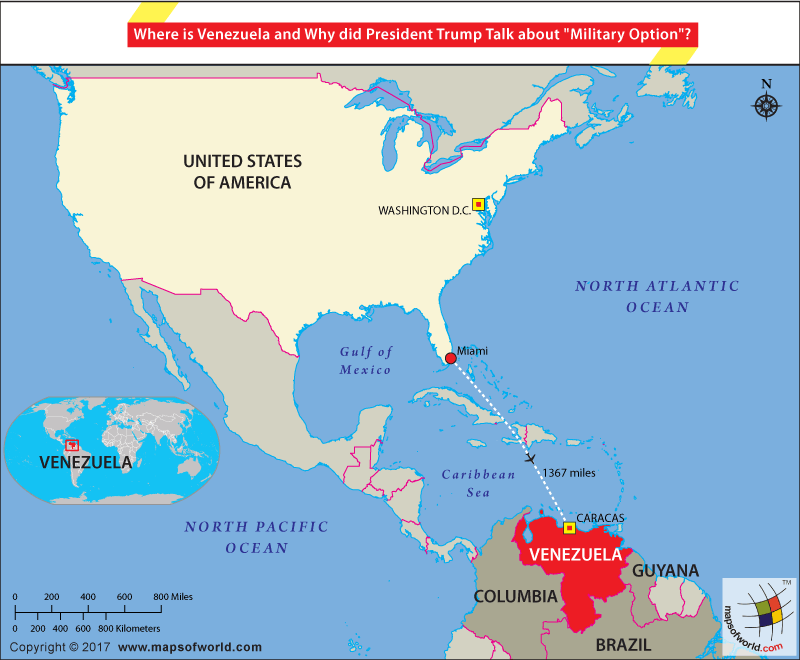Where is Venezuela and Why Did President Trump Talk about a “Military Option”?
Commenting on the fresh wave of violent protests in Venezuela, and the deepening crisis in the country, President Donald Trump warned of a possible military intervention in Venezuela. This is a significant escalation in Washington’s policy and came as a shock to the international community. The United States is currently also considering military action as a response to North Korea’s threats and missile buildup.
When asked about his position on the Venezuelan crisis, President Trump said, “The people are suffering and they are dying. We have many options for Venezuela, including a possible military option if necessary.”
To understand the context of President Trump’s statement here’s a look at Venezuela and its current political situation.
Where Is Venezuela?
Venezuela is located in northern South America. Venezuela is bounded by the Caribbean Sea to the north and the Atlantic Ocean to the northeast. It shares borders with Guyana to the east, Brazil to the south, and Colombia to the west. The distance between Miami, Florida and Caracas, the capital of Venezuela is 1367 miles (the flight distance across the Caribbean Sea).
The Legacy of Hugo Chavez
The crisis in Venezuela is certainly not a new one. Once a Spanish colony, Venezuela declared its independence in the early 1800s (from Spain in 1811 and from Gran Colombia in 1830). Through the rest of the century and through the first half of the 1900s, the political scenario in Venezuela was largely dominated by the caudillos, military leaders who controlled the various regions of the country. From the mid-1900s, Venezuela was administered by a series of democratic governments, one replacing the other, but one of these was able to get the country past the successive economic crises that demoralized the people. In 1999, Hugo Chavez, the self-styled leader of the Bolivarian Revolution, came to power, capitalizing on the widespread discontent prevalent in the nation. Venezuelans, however, did not find the respite they sought. President Chavez and his United Socialist Party (PSUV) imposed crippling socialist policies that further deepened the political and economic gloom in the Venezuela. Democratic institutions in the country were systematically destabilized by the PSUV. Relations with the United States were strained as Chavez time and again blamed the US for various assassination attempts, coup plots and even for a short coup in 2002. Since 2011, the United States has been imposing sanctions against various Venezuelan state enterprises, which has further crippled the Venezuelan economy.
Enter Nicolas Maduro
After the death of President Chavez, his successor Nicolas Maduro, also from the PSUV, took over. The Chavitas in the country (followers of Chavez’s political ideologies) support Maduro and claim that the president has done much to reduce inequality in the country. The masses, however, have grown disillusioned with the oppressive policies that have done nothing to alleviate poverty, unemployment, and the country’s economic woes. Maduro’s popularity has further plummeted with dwindling oil revenues, most of which went into sponsoring government projects.
The Current Crisis
According to Venezuela’s Finance and Economic Development Commission, Venezuela’s inflation for this year is pegged at 679.79 percent. The International Monetary Fund takes a grimmer view of the situation. The IMF estimates suggest that inflation for the year will reach 720.5 percent, and for the following year, inflation rates may go up to 2068.5 percent. Crime and poverty have been at their highest levels and Venezuela is suffering from a crippling medicine crisis. The economic woes have prevented the government from importing essential medicines and drugs, which has affected the health of the people.
On March 29th, 2017, the Supreme Court of Venezuela ruled that it would be taking over the National Assembly – the unicameral legislature of the country where the opposition holds majority seats. Taking over the National Assembly by pro-Maduro judiciary is largely akin to transforming Maduro into a dictator with unlimited powers. The decision was soon reversed, but it has left people disenchanted about the structure of their government.
Since about March of 2017, mass protests have been staged across Venezuela and many have lost their lives when these demonstrations turn violent. Since March, hordes of protestors have swarmed the streets of Caracas, the Venezuelan capital. Reports of stone pelting and grenade throwing incidents have only been outdone by the news of an increasing death toll and grave human rights violations. Shops and homes have been looted and Venezuela is finding itself increasingly in the grip of anarchy. Protestors have been demanding that presidential elections be undertaken immediately so that dissenters who have been held as political prisoners can be released, and Supreme Court justices who were part of the March 29 ruling can be removed.
Constituent Assembly
Instead of giving in to the demands for a general election, President Nicolas Maduro invited Venezuelans to elect members to a newly proclaimed National Constituent Assembly on July 30, 2017. This assembly is charged with drafting a new constitution. The Constituent Assembly will consist of 545 representatives, of which 364 will come from the municipal circumscriptions and the rest from the unions of the country. The Assembly is tasked with bringing in major reforms to the constitution, changing laws, and most importantly, dissolving the National Assembly. Predictably, President Maduro claimed victory in this election as well. Not only was this election boycotted by the masses, it was also deemed illegitimate by the US, Colombia, Peru, Mexico and many countries in Europe. The United Nations has also expressed doubts over the legitimacy of the election. A fresh wave of protests has rocked the country over the outcome of this election.
Venezuela’s Response to President Trump
Venezuelan Defense Minister Vladimir Padrino called out President Trump’s suggestion of a possible military action, stating “As Minister of Defense and as a citizen I say this is a crazy act, an act of supreme extremism.”
Related Maps:





